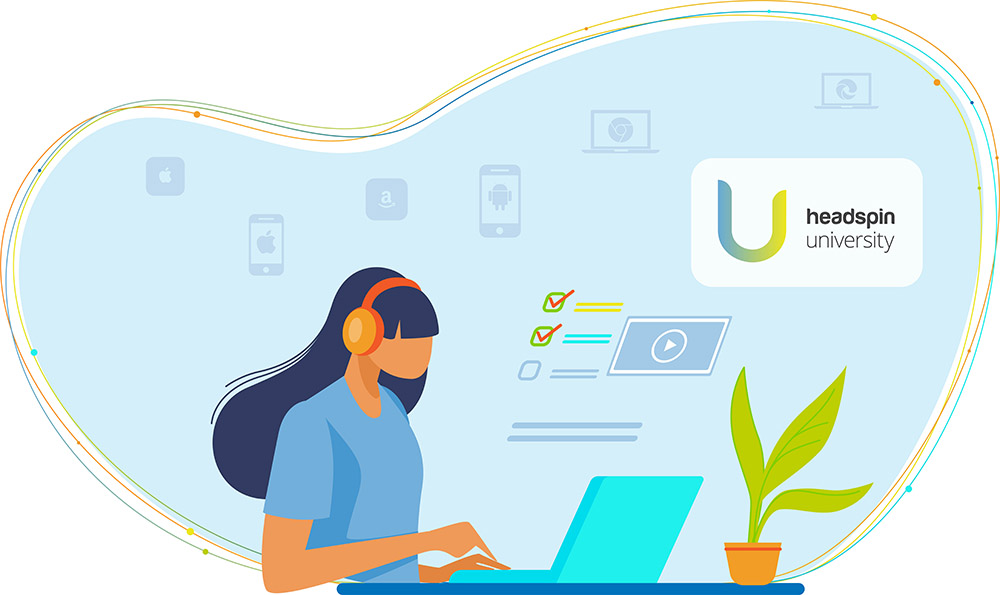
Appium Pro Training, Tutorials, and Certification
Self-Paced Online Appium Certification Course

While in-person workshops are on hold due to COVID-19, you can now access a 20+ hour video-based Appium and Selenium certification course taught by Jonathan Lipps, at HeadSpin University. Sign up today to get started with the best Appium training you can find!
View DetailsAppium & Selenium Fundamentals Course Overview
Take a closer look at the topics covered in this certification course below. The set of tutorials that make up the course has no prerequisites and is designed to teach you everything you need to know to become proficient at UI test automation! The course includes:
Enroll Now- 20+ hours of high-quality video instruction from Jonathan Lipps, Appium project lead
- An introduction to the Python programming language
- An in-depth introduction to testing and test automation concepts
- Coverage of advanced topics like test suite design
- Hands-on evaluation of your web and mobile automation skills using cloud-based devices at no extra charge
- A certification that actually means something, since you've proven your skills practically in order to achieve it!
Appium & Selenium Fundamentals Course Outline
1. Course Intro and Overview
We start off by covering what you will learn, what you already need to know, and how the course itself will work.
2. Introduction to Automated Testing
Before we dive into testing tools and techniques, it's important to understand testing from a high level. In this module we define testing and look at various test types and methods.
3. Python for Testing
The programming language I recommend for writing and running automated UI tests is called Python. In this module we go through a crash course on Python, learn about all the most important parts of the language, and finally write a simple unit test to put it all together.
4. Overview of Web and Mobile Testing
You'll get a look at the various tools that are available for you to use in the service of web and mobile test automation and a deeper look at the tools that are the focus of this course, in the context of the bigger picture: Selenium and Appium.
5. The WebDriver Automation Architecture
Selenium and Appium both share a common architecture, known as the WebDriver Architecture. We cover the special servers called "drivers" that make up this architecture which enable automation for a certain platform or browser, and "clients" which allow your test scripts to easily connect with the drivers.
6. Installation and Setup
You don't need to run Appium and Selenium locally for the purpose of taking this course, but it's a good idea to get set up locally anyway, because test development is best done on your own computer. This module takes you through the requirements and setup steps for Selenium, Appium, and the project we'll be building in this course.
7. Web Browser Automation Using Selenium
Learn the ins and outs of using Selenium for web browser automation via the specific drivers and driver classes available from the Python Selenium client. Topics include finding elements reliably, element interaction, and interaction with other browser objects like windows and alerts.
8. Mobile App Automation Using Appium
We take a deep dive into the basics of Appium, porting over our learnings from Selenium which include strategies for finding elements and interacting with them. We learn more about what's unique to Appium, including some idiosyncrasies of iOS and Android. Finally we explore some more advanced topics like touch-based gesture actions.
9. Additional Appium Modes and Features
Learn about some of the more advanced modes and features that Appium has to offer. Here we discuss techniques such as working with devices and apps outside of the app-under-test, and automating non-native apps (web and hybrid apps).
10. Test Suite Design
Now that we have a solid understanding of automation, we'll apply it to testing. We discuss all the aspects of a test suite and build one up from scratch using good practices.
11. Appium and Selenium at Scale
Constructing a solid test suite is only step 1. Beyond this, it's essential to think about how that test suite can be scaled into a robust and reliable CI/CD system, so we discuss all the topics related to this goal, including test flakiness and a summary of all the best practices that will assist you on your way.
12. Next Steps
Once you reach the end, we discuss some additional topics to explore and advice for getting started with your own app.
